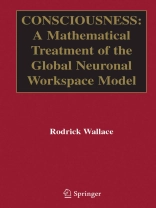This book is not an intellectual history or popular summary of recent work on consciousness in humans. Bernard Baars (1988), Edelman and Tononi (2000), and many others, have written such, and done it well indeed. This book, rather, brings the powerful analytic machinery of communication theory to bear on the Global Neuronal Workspace (GNW) model of consciousness which Baars introduced, and does so in a formal mathematical manner. It is not the first such attempt. The philospher Fred Dretske (1981), indep- dent of Baars, long ago outlined how information theory might illuminate the understanding of mind. Adapting his approach on the necessary conditions for mental process, we apply a previously-developed information theory analysis of interacting cognitive biological and social modules to Baars’ GNW, which has become the principal candidate for a 'standard model’ of consciousness. Invoking an obvious canonical homology with statistical physics, the method, when iterated in the spirit of the Hierarchical Linear Model of regression theory, generates a fluctuating dynamic threshold for consciousness which is similar to a tunable phase transition in a physical system. The phenomenon is, however, constrained to a manifold/atlas structure analogous to a retina; an adaptable Rate Distortion manifold, whose 'topology’, in a large sense, reflects the hierarchy of embedding constraints acting on consciousness. This view greatly extends what Baars has characterized as 'contexts.
Spis treści
Preface.- What is consciousness?- The Global Neuronal Workspace model. An introduction to information theory. The Shannon Coding Theorem. More heuristics: a 'tuning theorem’. The Shannon-Mc Millan Theorem. The Rate Distortion Theorem. Large deviations.- Fluctuations. The fundamental homology with statistical physics. Cognition as generalized language.- Theory. Two neural network examples. Interacting cognitive modules.- Representations. Language-on-a-network models. 'Biological’ phase transitions. Universality class distribution. Universality class tuning. More on behavior far from the critical point. Extending the model. The simplest tunable retina. Tuning the visual retina. The torus and the sphere. Expanding the workspace. Energy efficiency and consciousness. Where does all this lead? Sociocultural context as selection pressure. Autocognitive developmental disorder. Toward a 'General Cognitive Model’. Evading the mereological fallacy.- References. Appendix on coarse graining.












